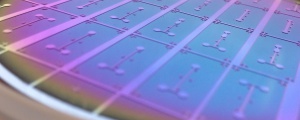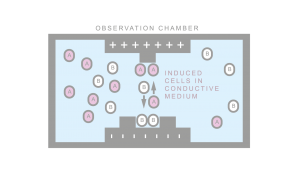| Line 11: | Line 11: | ||
Numerous methods of cell separation exist. Primitive methods ignore cellular composition (size based separation). Expensive methods utilize fluorescent markers together with expensive laser sorters (FACS). Other methods require exogenous labels and known protein interactions (magneto-phoresis). Such interactions can be non-specific. Hence, only sufficiently disparate phenotypes can be isolated. Dielectrophoretic separation is based on forces generated directly by the cellular makeup. Hence multiplexed separation and multilevel separation is possible. Programmed cells can also be used as probes for logic enabled labeling. Georgiev Lab in collaboration with Faculty of Electrical Engineering at the University of West Bohemia is interested in developing dielectrophoretic separation methods together with compatible biological devices. | Numerous methods of cell separation exist. Primitive methods ignore cellular composition (size based separation). Expensive methods utilize fluorescent markers together with expensive laser sorters (FACS). Other methods require exogenous labels and known protein interactions (magneto-phoresis). Such interactions can be non-specific. Hence, only sufficiently disparate phenotypes can be isolated. Dielectrophoretic separation is based on forces generated directly by the cellular makeup. Hence multiplexed separation and multilevel separation is possible. Programmed cells can also be used as probes for logic enabled labeling. Georgiev Lab in collaboration with Faculty of Electrical Engineering at the University of West Bohemia is interested in developing dielectrophoretic separation methods together with compatible biological devices. | ||
| − | + | == Dielectrophoretic cell focusing == | |
Dielectrophoretic cell focusing microfluidic device developed at Georgiev Lab. The presence of an electric field tuned to a specific frequency allows the cells to be focused by negative dielectric forces to the center of the channel. | Dielectrophoretic cell focusing microfluidic device developed at Georgiev Lab. The presence of an electric field tuned to a specific frequency allows the cells to be focused by negative dielectric forces to the center of the channel. | ||
<mediaplayer width='550' height='300'>http://www.ccy.zcu.cz/movies/DEP_Focusing.mp4</mediaplayer> | <mediaplayer width='550' height='300'>http://www.ccy.zcu.cz/movies/DEP_Focusing.mp4</mediaplayer> | ||
Revision as of 09:27, 6 March 2015
Microfluidics
Our Microfluidics Research focuses on the study of microfluidic transport phenomena and the design of microfluidic devices with applications in synthetic biology. Current research projects include design and development of sensitive cell sorting techniques, on-chip cell culture, bio-sensors and cell-to-cell communication analysis.
Cell sorting
Numerous methods of cell separation exist. Primitive methods ignore cellular composition (size based separation). Expensive methods utilize fluorescent markers together with expensive laser sorters (FACS). Other methods require exogenous labels and known protein interactions (magneto-phoresis). Such interactions can be non-specific. Hence, only sufficiently disparate phenotypes can be isolated. Dielectrophoretic separation is based on forces generated directly by the cellular makeup. Hence multiplexed separation and multilevel separation is possible. Programmed cells can also be used as probes for logic enabled labeling. Georgiev Lab in collaboration with Faculty of Electrical Engineering at the University of West Bohemia is interested in developing dielectrophoretic separation methods together with compatible biological devices.
Dielectrophoretic cell focusing
Dielectrophoretic cell focusing microfluidic device developed at Georgiev Lab. The presence of an electric field tuned to a specific frequency allows the cells to be focused by negative dielectric forces to the center of the channel.
The media player is loading...

